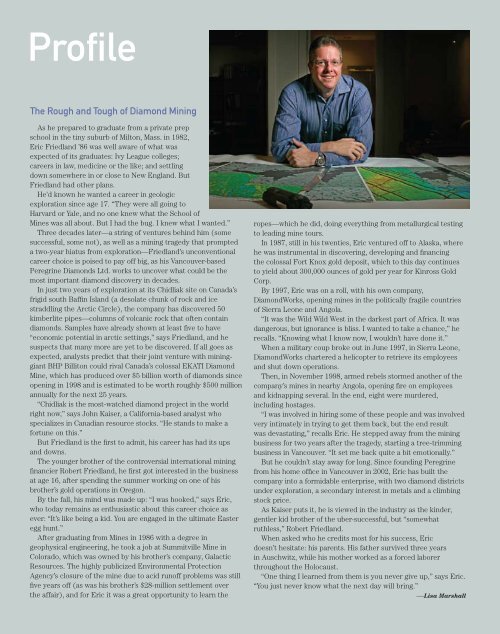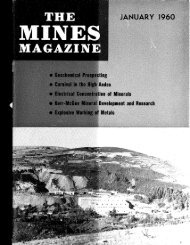Mines Magazine Turns 100 - the Timothy and Bernadette Marquez ...
Mines Magazine Turns 100 - the Timothy and Bernadette Marquez ...
Mines Magazine Turns 100 - the Timothy and Bernadette Marquez ...
- No tags were found...
You also want an ePaper? Increase the reach of your titles
YUMPU automatically turns print PDFs into web optimized ePapers that Google loves.
ProfileThe Rough <strong>and</strong> Tough of Diamond MiningAs he prepared to graduate from a private prepschool in <strong>the</strong> tiny suburb of Milton, Mass. in 1982,Eric Friedl<strong>and</strong> ’86 was well aware of what wasexpected of its graduates: Ivy League colleges;careers in law, medicine or <strong>the</strong> like; <strong>and</strong> settlingdown somewhere in or close to New Engl<strong>and</strong>. ButFriedl<strong>and</strong> had o<strong>the</strong>r plans.He’d known he wanted a career in geologicexploration since age 17. “They were all going toHarvard or Yale, <strong>and</strong> no one knew what <strong>the</strong> School of<strong>Mines</strong> was all about. But I had <strong>the</strong> bug. I knew what I wanted.”Three decades later—a string of ventures behind him (somesuccessful, some not), as well as a mining tragedy that prompteda two-year hiatus from exploration—Friedl<strong>and</strong>’s unconventionalcareer choice is poised to pay off big, as his Vancouver-basedPeregrine Diamonds Ltd. works to uncover what could be <strong>the</strong>most important diamond discovery in decades.In just two years of exploration at its Chidliak site on Canada’sfrigid south Baffin Isl<strong>and</strong> (a desolate chunk of rock <strong>and</strong> icestraddling <strong>the</strong> Arctic Circle), <strong>the</strong> company has discovered 50kimberlite pipes—columns of volcanic rock that often containdiamonds. Samples have already shown at least five to have“economic potential in arctic settings,” says Friedl<strong>and</strong>, <strong>and</strong> hesuspects that many more are yet to be discovered. If all goes asexpected, analysts predict that <strong>the</strong>ir joint venture with mininggiantBHP Billiton could rival Canada’s colossal EKATI DiamondMine, which has produced over $5 billion worth of diamonds sinceopening in 1998 <strong>and</strong> is estimated to be worth roughly $500 millionannually for <strong>the</strong> next 25 years.“Chidliak is <strong>the</strong> most-watched diamond project in <strong>the</strong> worldright now,” says John Kaiser, a California-based analyst whospecializes in Canadian resource stocks. “He st<strong>and</strong>s to make afortune on this.”But Friedl<strong>and</strong> is <strong>the</strong> first to admit, his career has had its ups<strong>and</strong> downs.The younger bro<strong>the</strong>r of <strong>the</strong> controversial international miningfinancier Robert Friedl<strong>and</strong>, he first got interested in <strong>the</strong> businessat age 16, after spending <strong>the</strong> summer working on one of hisbro<strong>the</strong>r’s gold operations in Oregon.By <strong>the</strong> fall, his mind was made up: “I was hooked,” says Eric,who today remains as enthusiastic about this career choice asever: “It’s like being a kid. You are engaged in <strong>the</strong> ultimate Easteregg hunt.”After graduating from <strong>Mines</strong> in 1986 with a degree ingeophysical engineering, he took a job at Summitville Mine inColorado, which was owned by his bro<strong>the</strong>r’s company, GalacticResources. The highly publicized Environmental ProtectionAgency’s closure of <strong>the</strong> mine due to acid runoff problems was stillfive years off (as was his bro<strong>the</strong>r’s $28-million settlement over<strong>the</strong> affair), <strong>and</strong> for Eric it was a great opportunity to learn <strong>the</strong>ropes—which he did, doing everything from metallurgical testingto leading mine tours.In 1987, still in his twenties, Eric ventured off to Alaska, wherehe was instrumental in discovering, developing <strong>and</strong> financing<strong>the</strong> colossal Fort Knox gold deposit, which to this day continuesto yield about 300,000 ounces of gold per year for Kinross GoldCorp.By 1997, Eric was on a roll, with his own company,DiamondWorks, opening mines in <strong>the</strong> politically fragile countriesof Sierra Leone <strong>and</strong> Angola.“It was <strong>the</strong> Wild Wild West in <strong>the</strong> darkest part of Africa. It wasdangerous, but ignorance is bliss. I wanted to take a chance,” herecalls. “Knowing what I know now, I wouldn’t have done it.”When a military coup broke out in June 1997, in Sierra Leone,DiamondWorks chartered a helicopter to retrieve its employees<strong>and</strong> shut down operations.Then, in November 1998, armed rebels stormed ano<strong>the</strong>r of <strong>the</strong>company’s mines in nearby Angola, opening fire on employees<strong>and</strong> kidnapping several. In <strong>the</strong> end, eight were murdered,including hostages.“I was involved in hiring some of <strong>the</strong>se people <strong>and</strong> was involvedvery intimately in trying to get <strong>the</strong>m back, but <strong>the</strong> end resultwas devastating,” recalls Eric. He stepped away from <strong>the</strong> miningbusiness for two years after <strong>the</strong> tragedy, starting a tree-trimmingbusiness in Vancouver. “It set me back quite a bit emotionally.”But he couldn’t stay away for long. Since founding Peregrinefrom his home office in Vancouver in 2002, Eric has built <strong>the</strong>company into a formidable enterprise, with two diamond districtsunder exploration, a secondary interest in metals <strong>and</strong> a climbingstock price.As Kaiser puts it, he is viewed in <strong>the</strong> industry as <strong>the</strong> kinder,gentler kid bro<strong>the</strong>r of <strong>the</strong> uber-successful, but “somewhatruthless,” Robert Friedl<strong>and</strong>.When asked who he credits most for his success, Ericdoesn’t hesitate: his parents. His fa<strong>the</strong>r survived three yearsin Auschwitz, while his mo<strong>the</strong>r worked as a forced laborerthroughout <strong>the</strong> Holocaust.“One thing I learned from <strong>the</strong>m is you never give up,” says Eric.“You just never know what <strong>the</strong> next day will bring.”—Lisa MarshallColorado School of <strong>Mines</strong> 43

















